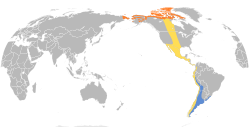From Wikipedia
Open on Wikipedia
| Baird's sandpiper | |
|---|---|

| |
| Baird's sandpiper (Calidris bairdii) | |
| Scientific classification | |
| Kingdom: | Animalia |
| Phylum: | Chordata |
| Class: | Aves |
| Order: | Charadriiformes |
| Family: | Scolopacidae |
| Genus: | Calidris |
| Species: | C. bairdii
|
| Binomial name | |
| Calidris bairdii (Coues, 1861)
| |

| |
| Range
Breeding Nonbreeding Passage
| |
| Synonyms | |
|
Actodromus bairdii | |
Baird's sandpiper (Calidris bairdii) is a small shorebird. It is among those Calidris species which were formerly sometimes included in the genus Erolia, which was subsumed into the genus Calidris in 1973.[2] The genus name is from Ancient Greek kalidris or skalidris, a term used by Aristotle for some grey-coloured waterside birds. The English name and specific bairdii commemorate Spencer Fullerton Baird, 19th-century naturalist and assistant secretary of the Smithsonian Institution.[3]
Description
[edit]Adults have black legs and a short, straight, thin dark bill. They are dark brown on top and mainly white underneath with a black patch on the rump. The head and breast are light brown with dark streaks. In winter plumage, this species is paler brownish grey above. This bird can be difficult to distinguish from other similar tiny shorebirds; these are known collectively as "peeps" or "stints".
One of the best identification features is the long wings, which extend beyond the tail when the bird is on the ground. Only the white-rumped sandpiper also shows this, and that bird can be distinguished by its namesake white rump patch.
| Standard Measurements[4][5][6] | |
|---|---|
| length | 14–17 cm (5.5–6.7 in) |
| wingspan | 36–40 cm (14–16 in) |
| weight | 32–63 g (1.1–2.2 oz) |
| wing | 117.6–125.3 mm (4.63–4.93 in) |
| tail | 50–57 mm (2.0–2.2 in) |
| culmen | 20.5–24.5 mm (0.81–0.96 in) |
| tarsus | 21.3–24.2 mm (0.84–0.95 in) |
Ecology
[edit]

Baird's sandpiper breeds in the northern tundra from far eastern Siberia to western Greenland.[5] They nest on the ground, usually in dry locations with low vegetation.
It is a long-distance migrant, wintering in western and southern South America, from Peru to as far south as Tierra del Fuego. This species is a rare vagrant to western Europe.[5] It breeds on barren high arctic coasts and hills, and on migration and in winter, it regularly uses lake shores and sparse grassland at extreme high altitudes (up to 4,700 m) in the Andes.[5]
Baird's sandpiper might have hybridized with the buff-breasted sandpiper.[citation needed]
These birds forage by moving about mudflats, picking up food by sight. They mainly eat insects, also some small crustaceans.[5]
References
[edit]- ^ BirdLife International (2018). "Calidris bairdii". IUCN Red List of Threatened Species. 2018 e.T22693404A129653281. doi:10.2305/IUCN.UK.2018-2.RLTS.T22693404A129653281.en. Retrieved 12 November 2021.
- ^ Ryser, Fred A. (1985). Birds of the Great Basin: A Natural History. Reno, NV, US: University of Nevada Press. p. 193. ISBN 0-87417-080-X.
- ^ Jobling, James A (2010). The Helm Dictionary of Scientific Bird Names. London: Christopher Helm. pp. 66, 84. ISBN 978-1-4081-2501-4.
- ^ Godfrey, W. Earl (1966). The Birds of Canada. Ottawa: National Museum of Canada. p. 154.
- ^ a b c d e Hoyo, Josep del; Elliott, Andrew; Sargatal, Jordi (1992). Handbook of the Birds of the World: Hoatzin to auks. Vol. 3. Barcelona: Lynx edicions. p. 523. ISBN 84-87334-20-2.
- ^ Sibley, David Allen (2000). The Sibley Guide to Birds. New York: Knopf. p. 185. ISBN 0-679-45122-6.
External links
[edit]- North American Peeps: A Different Look at an Old Problem (identification article covering this species and other small calidrids) Archived 2016-11-13 at the Wayback Machine at surfbirds.com Archived 2017-01-05 at the Wayback Machine
- BirdLife species factsheet for Calidris bairdii
- "Calidris bairdii". Avibase.
- Baird's Sandpiper Species Account – Cornell Lab of Ornithology
- "Baird's Sandpiper media". Internet Bird Collection.
- Baird's Sandpiper photo gallery at VIREO (Drexel University)
- Interactive range map of Calidris bairdii at IUCN Red List
- Audio recordings of Baird's sandpiper on Xeno-canto.
- Calidris bairdii in Field Guide: Birds of the World on Flickr
